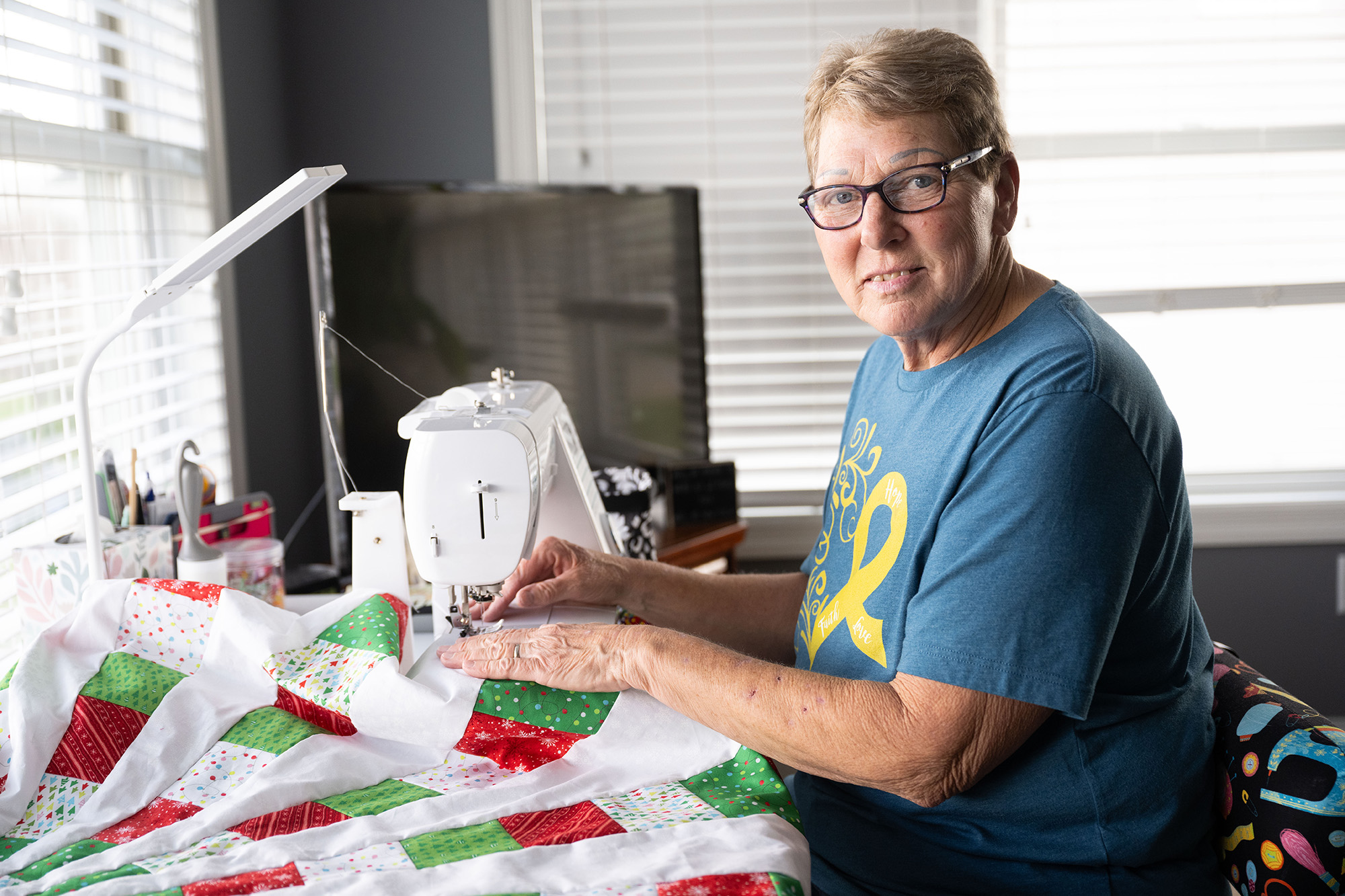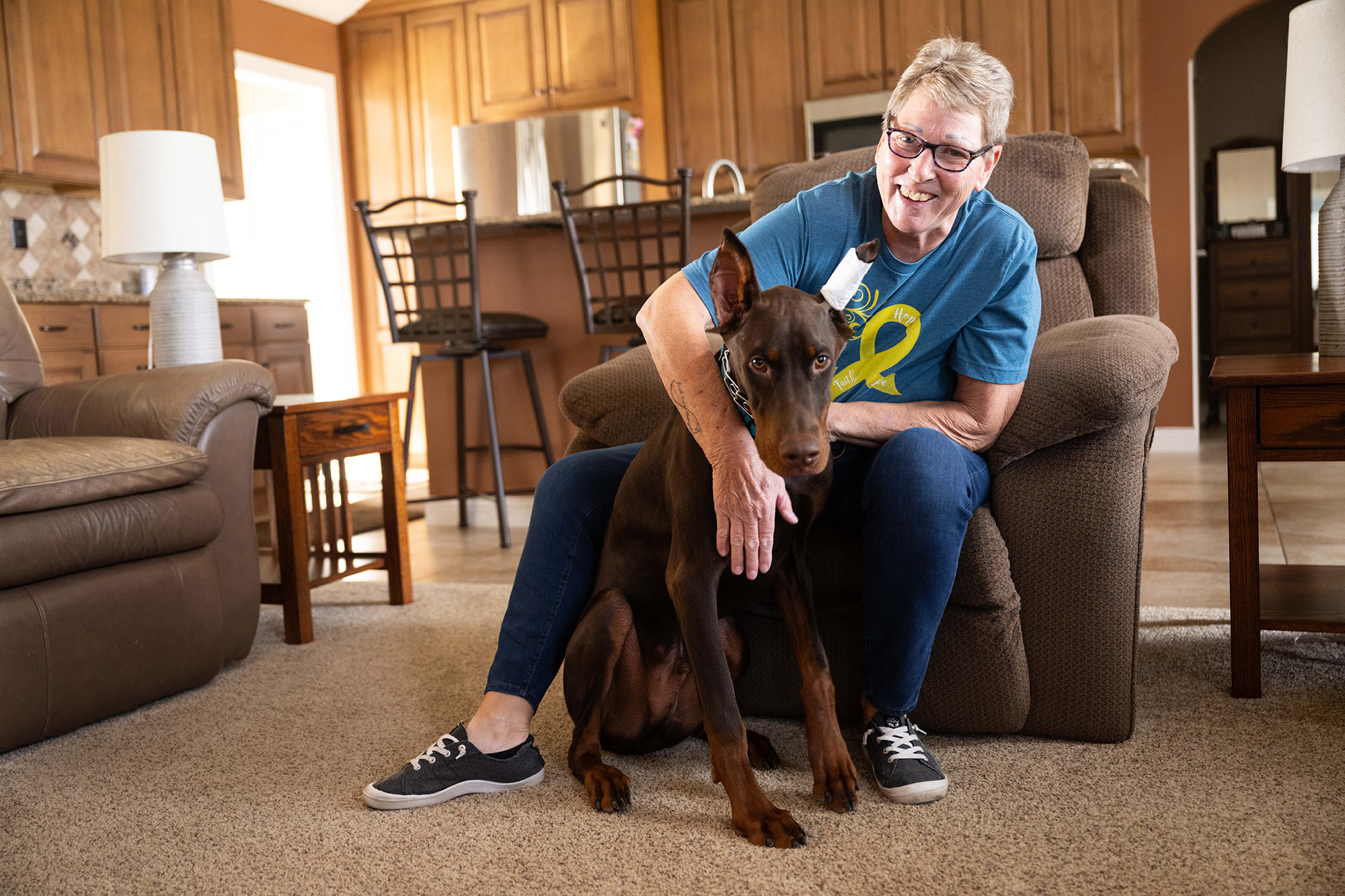Iowan sees new life after innovative cancer treatment

Story: Sara Epstein Moninger
Photography: Tim Schoon
By participating in cutting-edge research at University of Iowa Health Care, Linda Jacobs beat cancer. Now, she is relishing time with her grandchildren, exploring new hobbies, and training a puppy.
For years, cancer had its way with Linda Jacobs.
The DeWitt, Iowa, woman was diagnosed with breast cancer in 2015. She had a lumpectomy to remove the tumor only to have a different type of cancer develop in the other breast a few years later. At that point, she opted for a double mastectomy and radiation therapy. But in 2021 she developed radiation-induced angiosarcoma, a cancer that forms in the lining of blood and lymph vessels. She took an immunotherapy drug called Keytruda, and that kept the cancer at bay for a while. Until it didn’t.
Cue more surgery and more radiation. Unfortunately, the cancer was undeterred. Jacobs was spending a week in Florida with her husband when she noticed red blotches on her chest.
“Every morning, I woke up to more — and within a few weeks, I was covered. It was very aggressive,” says Jacobs, now 64. “When I lifted my shirt to show my local oncologist, her eyes grew as big as saucers. Then she left the room and came back with a referral to University of Iowa Health Care.”
Enter Mohammed Milhem, MBBS, an expert in melanoma and sarcoma and the Holden Chair of Experimental Therapeutics at UI Health Care Holden Comprehensive Cancer Center. Affectionately called “Dr. Mo” by his patients, Milhem is leading Iowa’s participation in a clinical trial investigating the effects of an injectable oncolytic virus that helps a patient’s immune system target cancer cells.
Milhem enrolled Jacobs in the study — out of 353 melanoma and sarcoma patients who received the drug in the nationwide study, she was one of 51 treated at Iowa. She also was among the one-third of participants whose tumors shrank within 12 months.
“I don’t think I would be here today without Dr. Mo. In fact, I’m sure I would not be here today without Dr. Mo.”
—Linda Jacobs, an Iowa woman who enrolled in a cancer clinical trial at Iowa under the care of Mohammed “Mo” Milhem
“I didn’t know anything about clinical trials at the time, but I had tried everything conventional. The pain was so intense I could not cross my arms in front of me, so when they offered this program, I thought, ‘Well, I’m going to die, or I can try this study,’” Jacobs says. “Ultimately, I wanted to be here for my grandkids — they are my world — so I was willing to do anything.”
More than two years after initiating the treatment with Milhem, Jacobs has no signs of cancer in her body.
“I come in for scans every three months, and so far, so good. I am cancer free,” she says. “It’s amazing. I don’t think I would be here today without Dr. Mo. In fact, I’m sure I would not be here today without Dr. Mo.”
Homing in on a cure
For her to receive the treatment, family members drove Jacobs the 70 miles to Iowa City every two weeks so that Milhem could inject her tumor with RP1, a genetically modified herpes simplex virus. The virus enters the cancer cells and causes them to break apart and die. The fragments then signal the patient’s white blood cells to seek and destroy cancer cells remaining in the body.
Each injection is followed by an infusion of a monoclonal antibody to prevent the cancer cells from suppressing the immune system. The treatment involves eight injections followed by continued infusions, is relatively well tolerated, and doesn’t require hospitalization.
“With angiosarcoma, Linda was facing a rare but very bad disease — the two-year survival rate before immune therapy was 0 — but after a couple of injections, I could see that the tumor was starting to disappear,” Milhem says. “Every time she came in, it looked better.”
Milhem, who studied medicine in Jordan and completed a residency and two fellowships at University of Illinois Hospital and Clinics in Chicago, joined the Iowa faculty in 2007. He was eager to get involved in clinical trials and intrigued by research that suggested drugs could help unleash the immune system’s ability to fight cancer. At the time, there were few immunotherapy trials; now, he says, there are nearly 10,000 — and discoveries are being made at a rapid pace, including at Iowa.
“With angiosarcoma, Linda was facing a rare but very bad disease — the two-year survival rate before immune therapy was 0 — but after a couple of injections, I could see that the tumor was starting to disappear.”
—Mohammed “Mo” Milhem, an expert in melanoma and sarcoma who led Iowa’s participation in a clinical trial investigating the role of an oncolytic virus in treating cancer
“There is a lot of sarcoma research being done here. We went from barely being a program when I started to now being a cohesive group that includes oncologists, surgeons, pathologists, nurse practitioners, and physician assistants. I’m very proud of my team,” says Milhem, one of only 67 sarcoma specialists in the U.S. “Iowa can train people in this disease in a way that many other centers can’t. I’ve trained two faculty members to be sarcoma doctors, and one of them left to build a program elsewhere. As the science gets synthesized in a better way, we’ll be able to move needles faster.”
Milhem says he is encouraged by RP1’s 33% response rate in the trial, noting that the drug has been submitted to the Food and Drug Administration for approval to treat melanoma. He hopes eventually it also will be approved to treat sarcoma. Although the approval process can take up to a year or longer, he says it would spur studies into applications for other types of cancer.
Clinical trials, Milhem says, are essential for finding out what works well — and why things might not work well.
“To get better results and move the science forward, you have to try new things. The only way to do that is through an informed pathway that allows the patient access to new therapies,” he says. “We still do not have all the answers, but we’re doing better, and every time we home in, we’re changing someone’s life. We’re saving a life. That’s fun.”

The walls in Milhem’s office are literally covered in gratitude — handwritten notes from patients he has helped over the years.
“I have about 400 thank-you notes, and that’s why I do what I do,” he says. “I don’t do it for the money. I don’t do it for the reputation. I’m a trench guy. I enjoy doing the work, and I love teaching about it. I like saving lives. I hate losing people.”
‘This treatment was a miracle’
Linda Jacobs had never been to Iowa City before seeking treatment at UI Health Care. Now, she says, she plans to make the trek for future health care needs.
“Dr. Mo was so upbeat. I just love him. He tells you what he’s doing and why he’s doing it, and he can relate to people,” she says. “But everybody in every department I was in was so nice, and they knew what they were doing. It’s my preferred place to go.”
RP1 will likely help many others, Jacobs says.
“I had a very aggressive and deadly disease, and this treatment was a miracle. I think it’s going to be great for people,” she says. “I’m on borrowed time — I’m happy every day I open my eyes.”
Jacobs, who retired from work in a radiology clinic in 2021 and learned to sew, fills her time doing things she loves: making quilts for loved ones, walking her new Doberman and taking him to puppy kindergarten, and visiting with her two grown children and two young grandchildren, who all live in Iowa.
“I’m feeling really good. I did have a knee replacement, but that went well and I’m on the mend,” she says. “If I can get my dog trained, I will be excellent.”

Iowa’s role in advancing cancer medicine
Cancer is among the leading causes of death worldwide, and Iowa has the second-highest and fastest-growing rate of new cancers in the U.S., according to the 2024 Cancer in Iowa report. Experts at the University of Iowa Health Care Holden Comprehensive Cancer Center are dedicated to fighting cancer and improving therapies.
With its “comprehensive cancer center” designation from the National Cancer Institute, Holden is one of 57 institutions across 36 states — and the only one in Iowa — recognized for its leadership, resources, and research in cancer medicine.
The providers at Holden see nearly 5,000 new cancer cases a year and enroll hundreds of patients in clinical research, with some 200 clinical trials underway at any one time.
Getting closer to a cure
Clinical trials at the University of Iowa and other cancer centers are key to making advances in cancer medicine.
